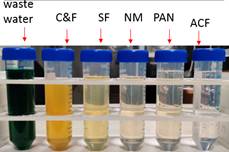The current 3-stage treatment process for wastewater consisting of primary, secondary, and tertiary treatment is unable to treat toxic industrial wastewater. The stand-alone AOP treatment technique for colour and odour properties in industrial effluents (dye-based) may be insufficient to meet set government standards and is also limited due to the high cost of AOPs involving continuous supply of chemical reagents. This is because it cannot remove the synthetic industrial dyes and the effervescent colour and odour, which have a long-lasting carcinogenic and toxic effect on the ecological and especially aquatic life. In order to remove this toxicity, an upgraded solution with the Advanced Oxidation Process (AOP) technology is the need of the day.
Working
towards this, researchers from the Indian Institute of Technology, Kanpur with
Malaviya National Institute of Technology, Jaipur and MBM College Jodhpur have
developed a modified AOP solution. This completely modified treatment process
consists of the primary dosing step followed by the sand filtration step,
another AOP and subsequent carbon filtration step. It eliminates the need for
the conventional primary, secondary, and tertiary processes resulting in
maximum colour removal and meets the inland water discharge standards.
Department
of Science and Technology (DST) Government of India (GoI) – Water Technology
Initiative (WTI), along with the Indian National Academy of Engineering (INAE),
supported the development of this technology at a pilot level in collaboration
with Laxmi Textile Prints, Jaipur for the commissioning of this pilot-scale
plant at Textile Industrial Park,
Jaipur.
The
much-improved Advanced Oxidation Process (AOP) technology targeting zero
discharge water management system is being utilized for the complete reuse of
industrial dye wastewater for domestic and industrial usage at a rate of 10
Kilo litres /day. The treatment of toxic and highly carcinogenic industrial
dyes of textile effluents is performed using this AOP technology for degrading
and mineralizing recalcitrant organic matter from effluent wastewater.
It is a
direct replacement of the existing treatment plant processes and consists of a
low-cost solution of dye adsorption on acid-modified soil followed by a
photochemical reaction step within a photocatalytic visible light filter and a
unique carbon and PAN nano-mat fibre filtration process. Having been set up on
a pilot basis, it remediates industrial wastewater.
The
technology has resulted in the recuperation of 50% of the treatment cost
incurred from conventional processes for water treatment (especially due to the
high cost of sludge disposability) in the water-scarce regions of Rajasthan.
Further, scaling up of this plant to 100 Kilo litres /day capacity to meet the
current industrial requirement is underway with automated plant operation

